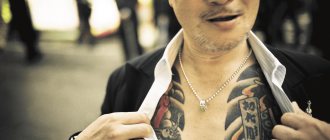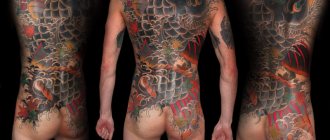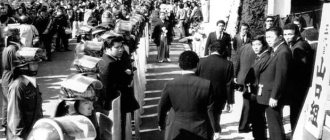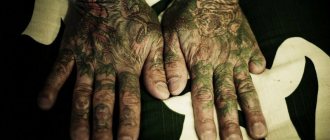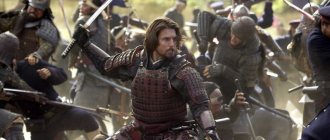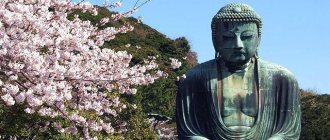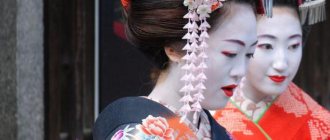Author: Felis Catus
09 August 2021 23:23
Tags: Japan mafia yakuza
192370
16
The Yakuza is one of the largest and most powerful criminal groups in the world, and, like the country in which it operates - Japan - it is shrouded in mystery. Hidden behind many layers of semi-legal businesses, this organization is an integral part of Japanese reality. Today we will lift the veil of secrecy over 15 of its secrets!
0
Source:
See all photos in the gallery
Yakuza is technically legal
0
Source:
The Yakuza operates openly in Japan. Its headquarters, decorated with identification marks - metal plates, can be found right on the streets. In addition, the yakuza operates several business networks in various fields - from construction to the porn industry. There are also Japanese mafiosi who operate illegally - for them the police have adopted the designation “boryokudan”.
Oyabun-Kobun Relationships
In traditional Japan, this resulted in the pair "oyabun" (literally, father) - "kobun" (literally, son). These relationships do not necessarily involve physical kinship - paternity can be adoptive, and even purely metaphorical. This can be - and often is - mentoring, in any field. In modern Japan, it is mostly symbolic, and is often spoken about even with a certain amount of irony (although all Japanese are familiar with the concept). For example, it could be a senior, experienced employee at work and a young, “green” newcomer. That is, these are “teacher” and “new guy”. Once upon a time, these relationships were much more serious, they were talked about almost as if they were real fatherhood (even his adoptive nature was often not obvious). The oyabun-kobun relationship implied the entire classical Confucian set of mutual obligations of father and son. To the point that “if the oyabun said that the crow is white, the kobun is obliged to agree with him,” as the saying goes. Today, in a similar “ideal” form, these relationships have been preserved in Japan only among the yakuza.
The entire structure of mafia clans rests on them - and often the relationships between them. They are sealed by appropriate rituals, and the rituals can reflect not only the relationship between an ordinary member and a boss, but also between two independent bosses and two clans as a whole. In their basic form, these rituals involve drinking sake together, with the amount of drink in the cups reflecting the mutual status of the participants. The older one has more sake, and the proportions are precisely regulated; a complex gradation has been developed for this purpose. Let’s say that today less attention is paid to the exact observance of details (unless a particular boss is a traditionalist, of course), but rituals exist. And once they were vitally important.
Felix Beato, 1870. Hand-colored photograph.
By the time Japan entered the “big world” - the opening of the country and the beginning of forced modernization (now known to historians as the “revolution” or “Meiji Restoration”) - the country already had a completely recognizable embryo of organized crime.
Now - like all of Japan - the Yakuza had to work very hard. Modernization, especially such a radical one, meant, first of all, very large construction (until 1914, the country's industrial production doubled, and the number of factories tripled).
Yakuza tattoos are made by hand
0
Source:
Members of the Yakuza can be immediately recognized by their bodies covered with tattoos. It is because of them that they wear clothes that completely cover their body in order to be able to be identified only “among their own.” Tattoos take up all the space on the skin, with the exception of a small strip between the chest and abdomen, which is left so that the liver does not fail. The traditional tattooing technique of Japanese mafiosi has been perfected over centuries, and it does not use electrical devices.
The Rise of the Modern Yakuza
When World War II began, some Yakuza members were drafted into the army, while others were sent to prison. As is often the case, the war caused a shortage of goods, which in turn led to the emergence of the black market and the modern yakuza bandits or "gurentai".
Gurentai drew conclusions from the actions of their predecessors and gradually took control of the entire country, especially since the black market was already under their control. By and large, no one could resist them, because the Americans destroyed the Japanese elite or took them into custody. As a result, in 1950, one might say, the Americans admitted their defeat to the Yakuza and declared that they could no longer protect ordinary Japanese from the Gurentai.
Around this time, the modern image of the yakuza emerged. Japanese mafiosi wanted to look like gangsters from American films and began to wear dark glasses, black suits with white shirts and ties. Samurai swords are a thing of the past, and they have been replaced by knives and pistols.
Wars began to divide the sphere of influence between factions. In these wars, civilians also suffered. By 1963, the number of Yakuza reached 184 thousand out of 5,200 groups, which exceeded the number of the Japanese Self-Defense Forces.
In the current situation, a person was needed who could restore order in the country. And such a person was found, he turned out to be Kodama Yoshio, who during the war was an adviser to the Prime Minister and a rear admiral. He was imprisoned by the Americans, where he began to cooperate with them. To begin with, he reconciled the Americans with the Yakuza. After which he became an intermediary between the largest clans, with the aim of uniting them. Thanks to Kodama's efforts, the yakuza clan system took on a modern look.
Their wives get tattoos too
0
Source:
The wives of yakuza members play virtually no role in their business; for the most part, they follow traditional ideas about a woman’s place in the family - raising children and taking care of the house. Nevertheless, the spouses demonstrate their devotion to their husbands by also applying tattoos to their bodies, and willingly show them off and pose for the camera. Yakuza members and their wives are almost the only group in Japan that gets tattoos; for other Japanese, these decorations are stigmatized as a “mafioso attribute.”
Initiation ceremony
A member of the Yakuza takes an oath of allegiance and seals the words with blood from a cut finger. Then the “recruit” and the boss take cups of sake (a Japanese rice drink) mixed with highly salted fish scales and sip them. Then they exchange them and slowly drink all the contents to the bottom, and the boss gets a full cup, but the newcomer does not.
After this initiation, the real parents lose authority, and their role passes to the boss and the “top” of the clan, who are now obliged to protect their new “son”.
They really help their country
0
Source:
Believe it or not, the Yakuza have come to the aid of their country in difficult situations many times. For example, during the earthquakes in Kobe, where many yakuza headquarters are located, a huge number of city residents were provided with safe shelters, and in general the yakuza responded to what was happening faster than the government.
Hierarchy
The Japanese Yakuza built their internal organization according to the traditional structure of their country: “father - children”, “older children - younger children”. Among themselves, older and younger children are considered brothers, regardless of whether there is a blood connection between them or not. The head of the Yakuza bears the proud title of “oyabun”, translated into Russian this is the same as chief. He is considered the boss of all, the one who stands above all the gang members.
After the chief in the bandit hierarchy there are: senior adviser, head of headquarters, deputy and assistant chief. All these criminal elements command a whole series of other criminal elements. The more people they influence, the more influence and respect they have from others. All of them are the heirs of the leader, and in the event of his death, one of them takes his place of honor.
The hierarchy also includes advisers, secretaries, accountants, and consultants. The bandits themselves in their structure have senior commanders, they are also called younger brothers, junior foremen, who are called youths, from the simple ranks of the Yakuza.
Occasionally, independent units appear in Japan - lonely yakuza. These are criminals who do not want to join already formed clans. However, they do not achieve success, because all the territories have long been divided, and it is simply impossible to recapture them from the clan.
They are outcasts in Japanese society
0
Source:
Descendants of the Burakumin, a Japanese outcast caste, make up up to 60% of all Yakuza members. The Burakumin, who became a separate group from the 11th century, were practically untouchable and engaged in “dirty” professions unworthy of the rest of the population. Many of them joined organized crime - no wonder the Yakuza was formed as a result!
Mungiki
This is one of the most aggressive sects in Kenya, which arose in 1985 in the settlements of the Kikuyu people in the central part of the country. The Kikuyu gathered their own militia in order to protect the Maasai lands from government militants who wanted to suppress the resistance of the rebellious tribe. The sect, in essence, was a street gang. Later, large detachments were formed in Nairobi, which engaged in racketeering of local transport companies transporting passengers around the city (taxi companies, car parks). They then switched to waste collection and disposal. Each slum resident was also obliged to pay representatives of the sect a certain amount in exchange for a quiet life in his own shack.
Origin of the name "Yakuza"
0
Source:
Many people have heard the word “yakuza”, but few know where it comes from. The term “yakuza” comes from groups of card players - bakuto, named after one of the combinations of the game oycho-kabu (Japanese version of poker). “I” translated from Japanese meant “eight”, “ku” - “nine”, “za” - a modified “san”, that is, “three”; the total is twenty, or the worst number in this Japanese card game. At first, the word “yakuza” began to mean “useless thing,” then “useless person,” and since the Bakuto were considered outcasts and losers, they began to associate themselves with a losing combination in cards. Subsequently, the name "yakuza" came to be applied not only to the bakuto, but also to all Japanese organized crime groups and is still used to designate them along with the term "boryokudan".
Facts about the Yakuza
Sinister Encounters
The yakuza runs bars called Host/Hostess clubs, where patrons can meet a hostess or host for drinks and conversation.
The host or hostess is the one who is responsible for greeting customers upon entering the restaurant with a smile. Receive them into the establishment, seat them and provide them with a menu. They are the organizer, the shepherd, the first and last impression of the restaurant. Keeping the restaurant tidy, making sure customers are happy, and keeping track of what's happening at each table are just some of the ways a host or hostess helps make the restaurant and its guests happy.
Seems innocent enough. In fact, Japanese girls and young women sometimes visit these clubs to feel like adults (to have an "adult experience" ). The owner convinces them to buy increasingly more expensive drinks (for which he receives a commission). At the end of the night, if the woman cannot pay the bill, she is forced to pay off her debts through prostitution. To make matters worse, the Yakuza have a system that ensures that these women, sometimes in their teens, will never be able to pay off their debts and will be forced to become sex slaves.
Bloody Yakuza Civil War
One of the worst Yakuza wars in history occurred in 1985. The problems began much earlier when the oyabun (patriarch/father) of the Yamaguchi-gumi, Kazuo Taoka, died of a heart attack. His deputy, Kenichi Yamamoto, was in prison, and it was decided that he would become leader when he was released. To the delight of the police, he died in prison. The lieutenants elected a new leader, but a man named Hiroshi Yamamoto was unhappy with the result. He formed his own gang, the Ichiwa-kai , and shot and killed their elected leader, starting a war. By the end of the conflict (from 1985 to 1989), 36 people were killed and hundreds were injured. The whole country followed the great battle of the largest Yakuza group and its rebel warlords: newspapers published daily reports in which they counted losses on both sides. Eventually the surviving rebels begged for mercy.
Yakuza. Farewell to Kazuo Taoka took place under police protection. 1985
Political participation
The yakuza are particularly large supporters and donors to Japan's right-wing Liberal Democratic Party (party president Shinzo Abe ). The LDP has been in power almost continuously since its founding in 1955, with the exception of the period between 1993-1994 and 2009-2012. She regained control of the government in the 2012 elections. It has 285 seats in the lower house and 113 seats in the upper house, and in coalition with Komeito the ruling coalition has supermajority in both houses. They also help strengthen support for the party by using their influence in rural areas where workers depend on their yakuza-owned companies.
Heirs of the Samurai
The yakuza have much in common with another famous Japanese class, the samurai. Their hierarchical structures are based on obedience and honor, they use violence to achieve their goals and believe that pride and honor are of paramount importance. Because of this, many people consider the Yakuza to be the modern-day heirs to the samurai legacy.
26. Bad hand
The Yakuza got their name from the Bakuto people. Bakuto (博徒) were traveling players active in Japan from the 18th to the mid-20th century. In the Japanese card game Oicho-Kabu (a game similar to Baccarat), the cards ya-ku-sa are 8-9-3, the worst possible hand that can be drawn.
Different views
Japanese police and media refer to the yakuza as "boryokudan", which means "violent group", a name considered offensive by members of the community because it also includes common gangsters. As for themselves, the Yakuza, they proudly call themselves "Ninkyō dantai", which means "organization of knights" . I guess no one would want to name their own gang after the Dead Hand in a card game.
Part of society
Yakuza members are often considered a normal and accepted part of Japanese society; in fact, membership is not illegal. Many receive pensions and pay taxes. Police believe that completely banning the yakuza will only force them underground and become even more dangerous.
US Operations
Over the years, the Yakuza expanded its activities throughout the United States, with the largest concentration of members in Hawaii. Members of the Sumiyoshi-kai syndicate collaborate with Hawaiian colored gangs in drug smuggling, racketeering, gambling, the sex industry, organizing the smuggling of American weapons into Japan, as well as financial fraud. The United States has added four Japanese mafia bosses to its sanctions list. They are part of the country's largest organized crime group, Yamaguchi-gumi.
Criminal background
The yakuza are believed to have originated in the mid-Edo period (1603-1868) from two distinct outcast groups, Tekiya (peddlers) and Bakuto (gamblers). Both groups were at the lowest and most despised social level, and gradually began to engage in more organized illegal activities.
From head to toes
One of the most common ways in which the Yakuza stand out in society is through their tattoos all over their bodies. This custom originates from the Bakuto , who covered their bodies with colorful tattoos. Tattoos are called irezumi and they usually cover the entire body except for a stripe down the middle of the chest. Having a tattoo is a symbol of wealth and they also prove a man's stamina because the traditional process is extremely painful and takes many hours and years.
Criminals in Japan were punished with facial tattoos.
20. Circumcision
The usual punishment for a crime in the Yakuza is the cutting off of part of the little finger, which is wrapped in a handkerchief and presented to the boss as an apology. In ancient times, one who was missing part of a finger could not use his sword skillfully, so he became dependent on his patron.
19. Pyramid
The Yakuza hierarchy is organized in the form of a pyramid. The patriarch, called kumicho, is at the top of the family, and his lieutenants, subordinates and other minor gang members move down the pyramid.
Relationship between son and father
All yakuza clans are related to each other by the oyabun-kobun relationship, roles that have been compared to teacher and student, as well as father and son. Kobun swears an oath to the oyabun of complete obedience and fidelity, in exchange for guidance and protection. Any clan member can be either a kobun or an oyabun, acting as a boss to those below him and subordinate to those above him.
17. Helping hand
Despite all their criminal activities, the Yakuza are also quick to lend a helping hand in times of need. After the 2011 tsunami, the organization was among the first to go to the affected areas. In 1995, after a terrible earthquake, the Yakuza delivered supplies using helicopters, scooters and boats. It has been suggested that their outcast background makes them sympathetic to people in trouble, but some people think this is simply a PR stunt designed to make it harder for the police to deal with them.
Yakuza killers?
Despite myths that portray the yakuza as ruthless killers, they are actually reluctant to kill unless in self-defense. Instead, they prefer to use lesser methods such as yubitsume (cutting off a finger) for punishment.
Sex and trade
Human trafficking is a big problem in Japan , and much of it is controlled by the yakuza, although it actually started out as an sanctioned operation. During World War II, they collaborated with the Japanese government to kidnap and supply women to Japanese soldiers and then to the American occupiers. Now the business has expanded to include pornography, human trafficking (often children) and sex tourism.
With honor
The Yakuza do not consider violent death to be something terrible. Violent death is considered poetic, tragic and honorable. They also have something of a Robin Hood complex and are known to help the poor steal from the rich. These romantic ideas help present them in a positive light to the public.
Division by three
The Yakuza organization is divided into three main syndicates. The largest syndicate is the Yamaguchi-gumi , which has over 55,000 members divided into 850 clans. The Yamaguchi Syndicate has extensive international operations. The Yamaguchi-gumi is one of the richest communities in the world of organized crime, generating billions of dollars in profits per year. They are also involved in stock market manipulation and creating pornographic websites.
Positive image
In 2012, to boost morale, the Yamaguchi-gumi syndicate distributed a newsletter to its regular members. The magazine's home page contains instructions for younger members on how to behave and uphold traditional Yakuza values. Haiku, fishing articles and calls for charity filled the rest of the magazine, in what was seen as an attempt to provide some publicity for the group. In 2014, Yamaguchi-gumi opened her own website, which is wildly popular.
Do it for me
The sakazuki ritual is the exchange of cups of sake between an oyabun (father) and a kobun (son). This is the most important ritual in the yakuza world and represents the strengthening of the bonds between them and the organization.
10. A man's world
There are very few women in high positions in the Yakuza organization. The few women who are recognized in the organization are usually the wives of the bosses and are referred to as an-san or big sister.
9. Cramming
If you're pursuing a life of crime in Japan because you're tired of school, I've got some bad news for you. All Yamaguchi-gumi members must pass a 12-page entrance exam. The test was created to ensure that its members are familiar with the law and will not get into trouble with the police.
8. Open
The Yakuza make no attempt to hide their headquarters and even have metal signs outside . They do this to focus on their legitimate business and allow their bosses to manage covert affairs from the "shadows" while keeping their hands clean from direct involvement in illegal activities.
Yamaguchi-gumi headquarters in Kobe
7. Stigma
Yakuza wives often receive the same tattoos as their husbands to show their devotion to their spouses and the criminal organization. They show off their tattoos at festivals and pose for pictures and the press. However, Japanese society still associates the yakuza with crime, and therefore they cannot appear in public places covered in tattoos.
Corporate blackmail
The yakuza practice a form of grand bribery or blackmail called sokaiya. They start by purchasing enough shares in the company to gain a seat at the shareholders' table. They find out all the possible dirt about the management and politely threaten to reveal this information at the meeting if they do not give them money or a controlling stake (raid takeover in Japanese). Since the Japanese fear nothing more than being embarrassed, this tactic is generally effective.
5. Fight back
Sokaiya became so common that in 1982 the country passed laws prohibiting corporations from paying for them. This had little effect on the Yakuza and simply forced them to find more subtle ways to racketeer. The most successful way corporations have found to fight back is to schedule their shareholder meetings on the same day. Since the yakuza cannot be everywhere at once, it effectively reduces the number of cases.
Adding a finger
If you look closely, you'll notice that the children's cartoon character Bob the Builder only has four fingers, but that's unless you're in Japan. The Japanese version of Bob is drawn with five fingers. Why? They didn't want little Japanese kids to think Bob was a member of the Yakuza.
Black market
In Japan, tattoos are highly frowned upon due to their association with the yakuza. Because of this, getting a tattoo in Japan is very expensive, as there are very few artists in the country. Sometimes a yakuza family will pay for someone's tattoo on the condition that they "take back what is theirs" after the person dies. This "art" is so valuable that it is sometimes removed from the owner's corpse, sold on the black market, and even displayed in galleries.
Tattoo shop in Yokohama producing amazing anime art
Samurai sword
The katana, the traditional samurai sword, is still used as a traditional killing weapon. The swords have been used in several high-profile crimes, such as the murder of Fujifilm vice president Juntaro Suzuki, who was killed in 1994 for refusing to pay the Yakuza.
Japanese Godfather
Kazuo Taoka, known as the "Godfather of Godfathers", was the third leader of the largest Yakuza organization from 1946-1981. He grew up an orphan and eventually took up street fighting in Kobe under the tutelage of his future boss, Noboru Yamaguchi. His signature strike, with his fingers into his opponent's eyes, earned him the nickname "The Bear". In 1978, he was shot (in the back of the neck) by rival gang members at a nightclub in Kyoto, but survived. A few weeks later, his abuser was found dead in a forest near Kobe.
Third kumicho Taoka Kazuo.
Views: 11,970
Share link:
- Tweet
- Share posts on Tumblr
- Telegram
- More
- by email
- Seal
Liked this:
Like
Yakuza members are forced to cut off parts of their fingers
0
Source:
If you can't see the tattoos on the body of a person who supposedly belongs to the Yakuza, look at his fingers. Sometimes entire phalanges of their fingers are missing. This is because when a member of the Yakuza makes a mistake, the internal code of ethics requires him to cut off the knuckle of his finger and present it to the boss. If the boss accepts the “gift”, the mistake is forgiven!
Traditions
This gang has a very strict code of conduct, which is probably why it has existed for so long. Everyone must have good relations with each other and unquestioningly obey the higher “leaders” of the criminal group.
Yakuza must remain loyal to their clan in any situation. If the boss orders you to take someone’s blame upon yourself, even if it means torture or prison, you must do it.
You cannot betray members of your family (group) and steal from them, enter into conflicts with other groups without the permission of the boss, and in no case should you “encroach” on ordinary law-abiding citizens. If one of the Yakuza members causes harm to innocent people, he will have to compensate them for the damage and be punished.
It is desirable for Yakuza members to have an official business, which would serve as a screen to hide the proceeds of criminal activity.
The Yakuza must perceive death as something inevitable (although it is inevitable for absolutely everyone) and not be afraid of its imminent onset. They must be intolerant of the enemy and build relations with him only from a position of strength. In some Yakuza clans, cannibalism is not prohibited (eating an enemy means helping the clan). You need to be able to endure hardships and pain, you cannot show fear in any situation (it is advisable not to experience it at all).
Many of the above qualities are good for all people to have, and these are the qualities that samurai in the past should have had. For the Japanese, Bushido (the code of conduct of samurai) is very important, because they often perceive the Yakuza as an organized group of some kind of noble Robin Hoods, helping to fight bad criminal manifestations in the country, even with the use of force, if necessary. And, of course, all this attracts young youths who want to connect their lives with the “real family” of the yakuza. And no one remembers their criminal business...
Chopping off phalanges of fingers in the Yakuza
If one of the members violates the laws of the Yakuza, he is subject to punishment - personally cutting off a finger (more precisely, a phalanx) using a katana sword or a tanto knife. The same punishment awaits those who decide to leave the ranks of the Yakuza. The cut off stump, wrapped in a rag, is given to the boss as proof of atonement. How many misdeeds - so many cut off fingers. In past centuries, systematic violation of Yakuza laws and, as a result, the loss of several fingers, led to the inability to hold a sword well in the hands (in those years it was the main weapon of the Yakuza), therefore malicious violators were recognized as unfit to perform their duties and were expelled from the clans by the boss . Now cutting off phalanges is a tribute to the rituals of the past.
In my opinion, the code of conduct of modern yakuza is very accurately characterized by the words of boss Yoshinori Watanabe: “Unconditional unity. Reckoning and silence. Necessary punishments and rewards, as well as appropriate use of force.”
But now all these strict Yakuza laws have become “worse,” which ultimately led to a weakening of discipline and its slow transformation into an ordinary organized criminal gang.
This is the largest gang in the world
0
Source:
The Yakuza is considered the largest gang in the world - the group consists of more than 100,000 people, not even counting the service personnel who are not full members of the Yakuza. The number 100,000 may seem large to you, but back in the 1950s and 60s. The Yakuza numbered about 180,000 people.
EXAMINATIONS
0
To become a member of Japanese crime, just knowing how to drink sake is not enough. Nowadays, there is a big hunt for the Yakuza by the state, which means you need to be well educated in the legal field so as not to get caught and drag the whole gang with you. In 2009, the Yamaguchi-gumi organization introduced a mandatory exam for its members. In addition to jurisprudence, it contains a variety of issues on criminal practice. Starting from how to steal vehicles to the problems of selling industrial waste.
The Yakuza have bases in America
0
Source:
If you think that the Yakuza's activities are limited to Japan, you are greatly mistaken. They are expanding not only into neighboring Asian countries, but also... into the USA! Their largest base in America is in Hawaii. Their main activities are drug smuggling to America and smuggling American weapons to Japan. There are also several yakuza syndicates operating in the United States; the funds of two of them were frozen by Obama personally not so long ago.
Law-abiding bandits
The Yakuza mafia is engaged in criminal activities of various types: they organize the sale of girls to Europe, America and Eastern countries, run their own brothels, involve minors in prostitution, distribute prohibited pornography, engage in illegal emigration and racketeering. Of all the world's criminal gangs, they are the most organized and, no matter how paradoxical it may sound, they respect the law more than other groups.
The group is divided into 750 clans and, together with all their members, constitutes the largest mafia in terms of the number of bandits in the whole world. Their main enemy is Chinese criminal gangs. The Yakuza and the triad, in other words, the Chinese mafia, are fighting, this is a tribute to tradition. The Chinese and Japanese have considered each other rivals for centuries.
Japanese rulers and the entire government of the country as a whole throughout history have set control over their entire state as their main goal. It doesn’t matter in what exact ways it had to be done. And so it turned out that the authorities themselves were engaged in control over everything that lies in the legal sphere, including business activities, and the Japanese mafia exercised control over the illegal sphere of life in the Asian state. The mafia never quarreled with the authorities, and they, in turn, did not interfere with them.
Yakuza will be one of the main beneficiaries of the 2020 Olympics
0
Source:
In case you didn't know, the 2020 Olympics will be held in Tokyo, which is great news for the yakuza; almost the entire construction business in Japan is controlled by this gang, and the Olympics will require the construction of many sports facilities. The involvement of the yakuza in this process became painfully obvious in 2015, when photographs of the head of the Japanese Olympic Committee and yakuza bosses together at events circulated online. The budget for the upcoming Tokyo Olympics is $50 billion, and even if the Yakuza's profit is only 5% of that, it will be quite impressive.
Sokaiya technique
When a newcomer passes all the tests, he is allowed to study criminal practices. And one of the most common practices is “pumping out money.”
The essence of the sokaiya technique is as follows: a mafioso buys up part of the company’s shares, becoming a member of the board of directors, and then begins to dig under the head of the company. Its purpose is to find personal information. If such data becomes known to the decoy, he begins to blackmail the manager.
The Japanese value status very much, and the fear of being disgraced is a vulnerable point for every respectable citizen. Therefore, directors of large enterprises are sometimes willing to pay huge amounts of money so that their secret hobbies do not become public knowledge. And if a person agreed to the blackmailer’s demands, they will no longer leave him alone.
Yakuza members are far right
0
Source:
The Yakuza is very close to the right-wing nationalist groups in Japan. The number of Japanese radical right-wing groups is about 100,000 people, and this number is suspiciously close to the number of the yakuza. However, there is no room for suspicion here - everything is already known: in Japan they are well aware that we are often talking about the same people. These people cannot be arrested for their radical views - they are guaranteed freedom of expression by the country's constitution.
Montreal Mafia Rizzuto
The Rizzuto are a crime family primarily based in Montreal, but also in the provinces of Quebec and Ontario. They once merged with families in New York, which ultimately led to the mafia wars in Montreal in the late 70s. Rizzuto owns hundreds of millions of dollars worth of real estate in different countries. They own hotels, restaurants, bars, nightclubs, construction, food, service and trading companies. In Italy they own companies producing furniture and Italian delicacies.
The most famous "godfather" of the Yakuza was a true legend
0
Source:
From the 1940s to the 1980s. The Yakuza syndicate Yamaguchi-gumi was led by a man named Kazuo Taoka. He was one of the most legendary bosses in Yakuza history. His parents abandoned him, after which he was “adopted” and then hardened in various battles by the Yakuza. In 1936, he went to prison for 8 years for murder, but upon his release, he gained popularity and became a respected leader. It was Taoka who turned his syndicate into one of the most powerful Yakuza groups. A survivor of numerous shootings, he died of a heart attack in 1981.
Structure
Structure of the Yakuza
The Yakuza is headed by a high boss (or chief). Subordinate to him are the saiko komon (administrator), waka-gashira (senior lieutenant or boss of the regional clan) and shatei-gashira (junior lieutenant). Lawyers and accountants report to Saiko Komon, while bandits of lower-ranking groups report to regional chiefs and shatei-gashira.
The boss of a yakuza clan has complete power over his subordinates and finances.
The Yakuza try to attract young people into their ranks; as a rule, these are 20-year-old boys familiar with crime. Anyone who joins the clan does not immediately become an equal representative of the clan - he undergoes an “internship” for three years, proving his suitability.
Each clan hunts in a certain territory, the boundaries of which it leaves only in emergency cases - when receiving a very lucrative offer or to fight with opponents.
Each Yakuza clan has its own “office”, the address of which is in the telephone directory and can be identified by the clan emblem hanging above the entrance to the premises.
Sometimes bloody territorial “disputes” arise when a more powerful clan seizes other people’s territories, thereby strengthening its power.
As we mentioned above, particularly distinguished Yakuza members receive rewards. As a rule, their immediate bosses give them lands, which the recipients will “supervise”, receive profits and pay a certain percentage to the clan.
The Yakuza were once led by women
0
Source:
After Kazuo Taoki, the boss's place was to be taken by another person chosen by him personally; the only problem was that he was in prison at the time of Taoki's death. While the syndicate was waiting for the new leader to be released, he died of liver problems. Taoki's widow, Fumiko, became the acting head of the syndicate; this happened for the first time in the history of the organization. It was she who found a new source of income for the gang - drugs.
Yakuza principles and beliefs
The Yakuza advocate the revival of samurai traditions, as well as traditional family values.
The Yakuza has a division into the Yakuza and the simpletons (“Katagi”), that is, those who do not belong to them. Killing katagi is not allowed, as the yakuza adhere to the samurai code of honor. This can only be done if the katagi threatens the clan’s activities. However, everything else (blackmail, rape, racketeering) is permitted.
Naturally, it is allowed to kill other yakuza. Sometimes, during wars between clans, they may use kamikaze killers (“teppodama”).
The Yakuza do not trust women and believe that they should take care of the home. This is why women are not accepted into the ranks of the Yakuza. The Yakuza respect only the wives of the clan head and call them “big sisters” (ane-san). In some cases, when kumicho are in hospital or prison, they may even be consulted. And the rest of the women are treated like litter.
Personal honor and the honor of the clan are the most important thing for any yakuza. Therefore, the Yakuza cannot stand being humiliated and insulted. They also almost never admit their mistakes or apologize.
It is customary for the Yakuza to support and help each other. If one of the group members ends up in prison, they try in every possible way to help him get out of there. And covering up for a “colleague” is revered as great valor.
Yakuza controls Japan's porn industry
0
Source:
It is a widely known fact that one of the main sources of income for the yakuza in Japan is the porn industry, which they keep under their complete control. Porn films are illegal in Japan, so the yakuza fills this black market gap. The Yakuza also cooperates with porn businesses from other countries (for example, from the United States) and imports girls of foreign origin to Japan for filming. These girls are usually blackmailed into doing porn.
Own magazine and website
The openness of the Japanese mafiosi is evidenced not only by the presence of legal businesses and clan offices. For example, in 2003, the Yamaguchi-gumi gang launched its own corporate magazine, Yamaguchi-gumi Shinpo. It is distributed among members of the group and is intended to bring the family together, talk about difficult times for Japanese crime and touch on common topics such as the game of Go, fishing, etc.
The bosses of Yamaguchi-gumi went further and not long ago opened a gang website. Moreover, the syndicate’s portal is no longer intended for members of the group, but for the general public. The purpose of its creation was to rebrand the gang, an attempt to change the negative attitude towards the yakuza in Japan.
Mexican drug cartels
Mexican drug cartels have existed for several decades; since the 1970s, some Mexican government agencies have been facilitating their activities. Mexican drug cartels have intensified since the collapse of the Colombian Medellin and Cali drug cartels in the 1990s. Mexico is currently the main foreign supplier of cannabis, cocaine and methamphetamine to the United States, and Mexican drug cartels dominate the wholesale illicit drug market in the United States.
D-Company
This group, which is based in India, Pakistan and the UAE, is led by Dawood Ibrahim. The organization's activities include extortion and terrorist acts. Thus, in 1993, it was responsible for the Bombay bombings, which killed 257 people and injured more than 700. D-Company is said to be financed by billions of dollars from real estate transactions and banking scams.
